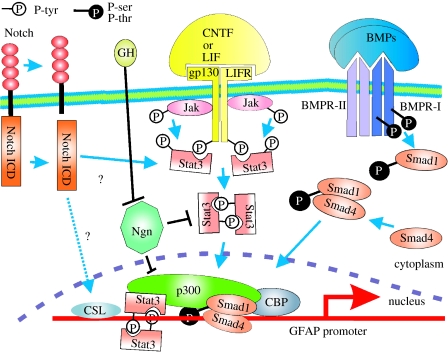Figure 2.
Signalling pathways involved in the induction of astrocyte specification/differentiation. Astrocyte differentiation is thought to be induced via cytokine and/or BMP signalling pathways. Cytokines (LIF or CNTF) induce dimerization of the LIF receptor (LIFR) with co-receptor gp130, leading to phosphorylation and activation of Janus kinases (Jaks). Receptor dimerization also creates docking sites for the transcription factor Stat3, which is tyrosine phosphorylated by Jaks. The phosphorylated Stats dimerize and move into the nucleus, recruiting p300 and binding to specific sequences in the GFAP promoter. BMP dimers induce the tetramerization of the BMPR-I and BMPR-II receptors, which are serine–threonine kinases. BMPR-II then phosphorylates and activates BMPR-I, which phosphorylates Smad1. Phosphorylated Smad1 associates with Smad4 (unknown stoichiometry) and the complex moves into the nucleus, recruiting p300 and CBP, which probably bind directly to the GFAP promoter and initiate transcription. Smads and Stats bind opposite ends of p300, which presumably allows synergistic integration of LIF/CNTF and BMP signalling pathways. These signalling pathways can be inhibited by neurogenins, which are thought to act by blocking Stat dimerization and also by sequestering p300. The activity of neurogenin can be inhibited, in an undefined manner, by growth hormone. Notch signalling (via the cleaved/released intracellular domain) might also interact with the Stat pathway. See text for a fuller description.

